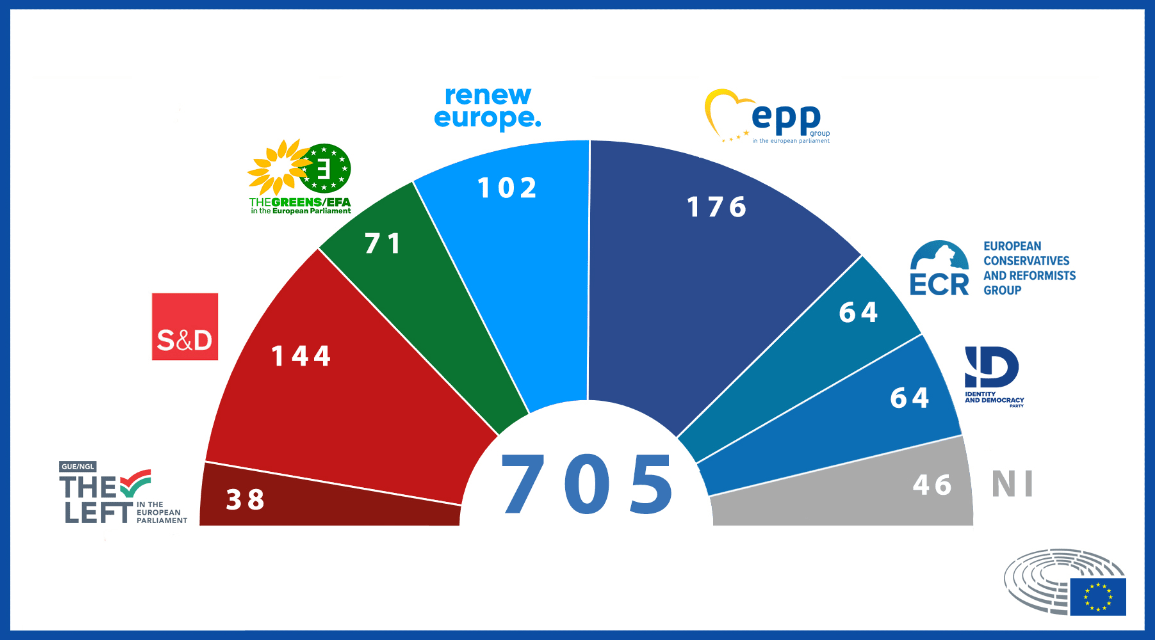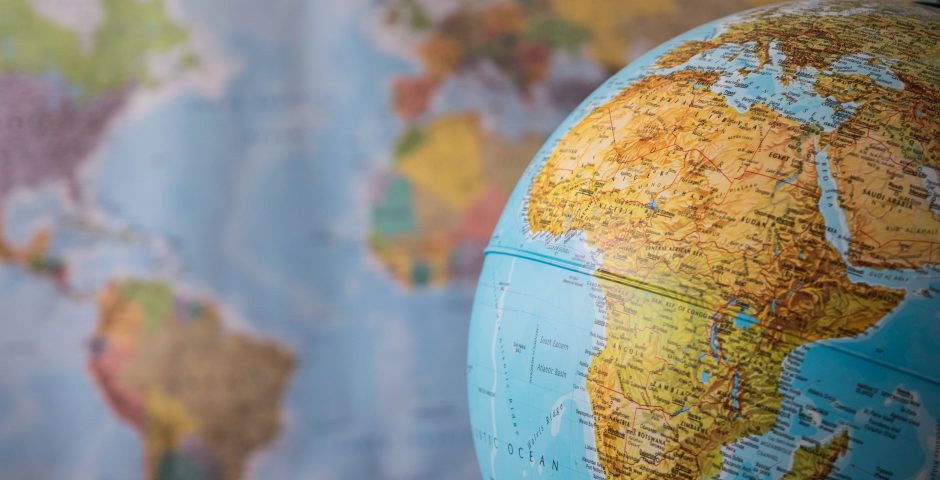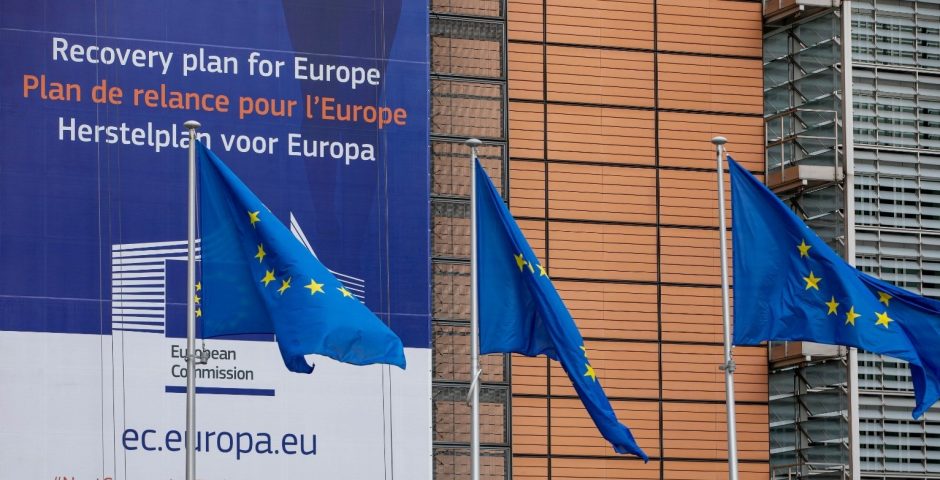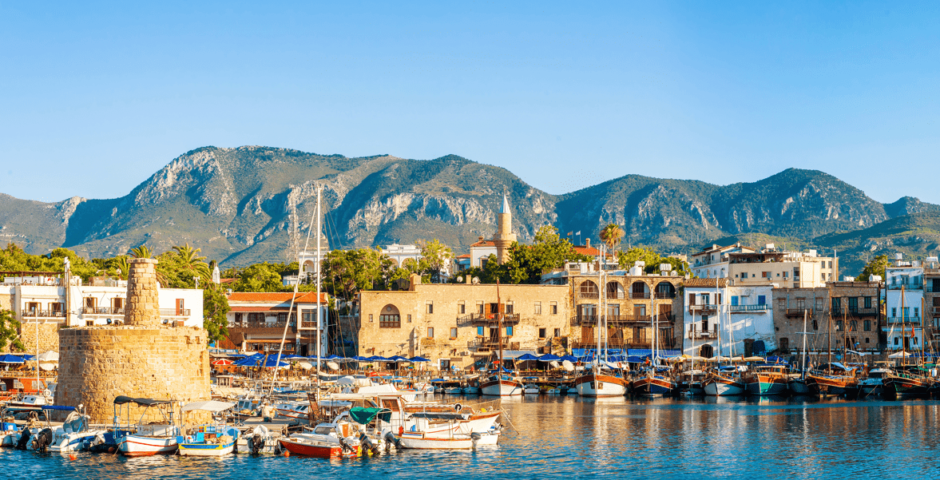The different political groups in the European Parliament

The political groups in the European Parliament at a glance.
When you think of European Union (EU) politics, one of the first things that will probably come to mind is that it is all quite complicated. In this article, you have already read all about European political parties and how they differ from national parties, but that does not complete the puzzle. An important part of politics in the European Parliament is the political groups, which you will undoubtedly see a mention of in the period before we go to the polls in June. In this article, you will read all about what political groups exactly are, what they do, and which ones there are.
Political groups in brief
There are currently seven political groups in the European Parliament, all of which get to elect their own chairmen and vice-chairmen. This group of chairpersons and the president of the European Parliament, currently Roberta Metsola, together make up the Conference of Presidents, which, among other things, determines what is discussed at plenary sessions.
More than 200 national political parties are represented in the European Parliament, divided into groups formed based on political ideology. This is done because MEPs do not serve the interests of the country they come from, but the entire population of the EU. So an MEP from the Netherlands represents not only the Dutch population but also that of Spain, for example, although Spaniards cannot vote for this MEP. Classification by political ideology has existed since the establishment of the General Assembly of the European Coal and Steel Community in 1953. Even then, no distinction was made based on nationality, but on political preferences.
A political group is a political alliance between MEPs who share the same political beliefs. This shared political identity is often quite general and broad. During Parliament meetings, group members sit together in different zones with the leftmost group, called the European United Left/Nordic Green Left, on the left side of the meeting room and the rightmost group, Identity and Democracy, on the right. So you can also tell from the seating arrangement where a party is roughly located on the political spectrum.

Seat allocation European Parliament (source: European Parliament website)
After the elections, most MEPs choose to join a political group or form a new one. An official political group must have at least 23 members from a quarter of all member states. In practice, this means that a political group must have members from seven different countries. To form a new political group, an announcement must be sent to the president of Parliament stating the name of the group, its members and who will be its president.
The main role of political groups is to form a common position on issues dealt with in plenary sessions that represent the interests of their constituents. Before voting in plenary sessions, parliamentary committee reports are reviewed by the groups and, if necessary, they submit amendments. In addition, the group’s position is discussed and adopted, but members are not obliged to vote or follow the group’s position.
A tour of all political groups
Over the years, the number of political groups in the European Parliament has changed from time to time. Sometimes one is added or two groups merge. There are currently seven political groups, with 705 seats. Below you will find all the political groups, in order of the number of seats obtained in the previous elections, with all the important points you should know about them.
The European People’s Party (EPP)
The EPP is a centre-right group in which mainly parties with a Christian Democrat ideology are represented. The EPP has always been the largest group within the European Parliament since the 1999 elections, obtaining 176 seats in 2019 with members from all member states except Estonia. Besides being the largest group, it is also the oldest; the group was founded back in 1953 under the name ‘Christian Democratic Group’. In 1979, the group was given its current name. At this moment, a member of the German CDU, Manfred Weber, is the group’s chairman. On 3 March 2021, Fidesz, the political party of Hungarian President Viktor Orbán, quit the group after disagreements over the group’s direction.
The EPP is strongly pro-European and thus in favour of further integration. The group stands for having a common market that acts competitively on the international stage while promoting the welfare of people worldwide. It values sustainable development and a citizen-centred European democracy.
Progressive Alliance of Socialists and Democrats (S&D)
European socialists are represented in the centre-left Progressive Alliance of Socialists and Democrats. It consists of various social-democratic or labour parties. Although the group was the largest for a long time, with 233 seats at its peak in 1999, the leading position has now been taken over by the EPP. Nevertheless, with 144 members from all member states, except Czechia and Ireland, the S&D is still the second-largest group in Parliament. In addition, the S&D is also the second oldest group; in fact, it has been a social democratic group since 1953. Spain’s Iratxe García Pérez currently chairs the S&D.
Many of the S&D group’s ideas are not very surprising if you are somewhat familiar with the general positions of many social democratic parties. Attention is mostly given to an inclusive European society based on equality, solidarity and justice. In addition, improving living and working conditions and ensuring more employment are central.
Renew Europe
Renew Europe, RENEW for short, is a new group that brings together the liberal and liberal-democratic parties in the EU. Until 2004, liberal democrats were united in the European Liberal and Democratic Party (ELDR) group. This group merged into the Alliance of Liberals and Democrats for Europe (ALDE) in November 2010. On 12 June 2019, the name was changed to Renew Europe. With 102 parliamentarians from 24 countries, RENEW is the third largest group in Parliament. Amongst its parties, you will find Renaissance, the political party that was founded by French President Emmanuel Macron in 2016. RENEW’s president is France’s Valérie Hayer, who was elected on 25 January 2024.
The core values of the Renew Europe group are democracy, sustainability and prosperity. Its emphasis is on conducting European politics that focus on issues such as personal freedoms, free enterprise and social solidarity. In addition, RENEW supports reform of the EU’s various institutions to make European politics more transparent.
The Greens/European Free Alliance (Greens/EFA)
As its name suggests, this group is a merger between two parties, the European Greens and the European Free Alliance. The Greens/EFA mainly represents parties focusing on regional interests, such as Catalan parties, Plaid Cymru from Wales, or the Fryske Nasjonale Partij. The group has existed since 1999 and, with 71 MEPs from 17 countries and three regions, it is the fourth largest group in the European Parliament. Germany’s Ska Keller and Belgium’s Philippe Lamberts co-chair the Greens/EFA.
Within the group of the Greens/EFA, human rights and the environment are central, so in effect there is one main position for each party. In practice, this manifests itself in a combination of focusing on the environment and social justice, tackling climate change through more green energy while guaranteeing human rights for all.
European Conservatives and Reformists (ECH)
As its name suggests, the European Conservatives and Reformists group consists of conservative political parties. The group split from the EPP in 2009 under the leadership of former British prime minister David Cameron. In the 2019 elections, the group won 64 seats, largely occupied by members of the Polish Law and Justice party. This makes the ECH the fifth largest group in Parliament. The group has two chairpersons; Poland’s Ryszard Legutko and Italy’s Nicola Procaccini.
The ECH group is generally centre-right. Its constituency consists of a combination of social conservatives and supporters of economic liberalism. The ECH is critical when it comes to European cooperation but is not outright Eurosceptic. In particular, it emphasises a commitment to economic cooperation and free trade but restricts cooperation in other areas. So you could say that the group, to some extent, wants an EU that more closely resembles its predecessor; the European Economic Community.
Identity & Democracy (I&D)
Identity and Democracy is the youngest group in Parliament. I&D was formed in June 2019 as a successor to Europe of Nations and Freedom, which was formed in 2015. The group was founded by the Danish People’s Party, the Finnish Party, Germany’s AfD, and Italy’s Lega. Other parties later joined, including Belgium’s Vlaams Belang, France’s Rassemblement National, and the Dutch PVV. The group currently has 64 seats, mostly occupied by members of Lega and Rassemblement National, making it the sixth-largest group in Parliament. Italian Marco Zanni is the current group leader.
Known as euro-critical, the I&D group is composed of nationalist, (extreme) right-wing parties that were originally members of the conservative ECH. Its central focus is on preserving the national sovereignty of all member states and opposing further integration by limiting the number of EU competencies. In addition, the group favours a stricter migration policy and wants to end the accession negotiations with Turkey.
European United Left/Nordic Green Left (GUE/NGL)
Finally, with 38 seats, we arrive at the smallest group in Parliament; the European United Left/Nordic Green Left. This left-to-far-left group consists mainly of parties with socialist and sometimes even communist backgrounds. The European United Left came into being in 1989. After EU enlargement, leftist parties from Sweden and Denmark were added in 1998 and the group took the name we know today. The presidents of the group are France’s Manon Aubry and Germany’s Martin Schirdewan.
The GUE/NGL group has eurosceptic traits, but not in the same manner as the I&D group. The scepticism manifests in an anti-capitalist perspective rather than a desire for more national sovereignty. Thus, while the group favours further European integration, it opposes the current neoliberal nature of the EU. GUE/NGL aims to promote cooperation between stronger and weaker member states. In addition, more attention should be paid to the environment.
Non-attached members
Not all MEPs are members of a political group. These members are also called non-attached. There are currently 46 non-attached Members from a wide variety of political backgrounds. These include members of the populist Italian Five Star Movement and the Greek Communist Party.
Like all other MEPs who do belong to political groups, non-attached Members may table motions, ask questions, and give explanations of vote. However, there are also differences between non-attached and group members. For example, non-attached Members may attend the Conference of Presidents but do not have the right to vote there. In addition, it is much more difficult for non-attached members to take initiatives that require a minimum number of members.
Predictions for the coming elections
Although it is still some time before we go to the polls to vote in the Parliamentary elections, there are already plenty of predictions being made. In line with the broader trend, the expectation is that (far-right) and populist parties will do well in European Parliament elections, just like in many national elections held in recent years. This is likely to mean that the I&D group will grow to become a lot larger. This is linked to a loss of seats for the leftist groups GUE/NGL and Greens/EFA. At the same time, the EPP is traditionally expected to become the largest again. However, these are all still predictions, for the real results we will have to be patient.
Sabine Herder has a master’s degree in Crisis and Security Management from Leiden University and is now doing a master’s in European Policy at the University of Amsterdam. Before this, she did a bachelor’s degree in Liberal Arts and Sciences with a major in International Relations.
Header image: Shutterstock
In-text image: European Parliament website




